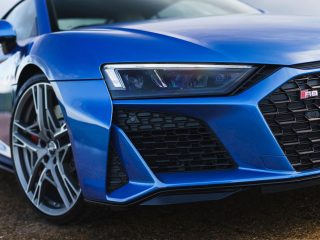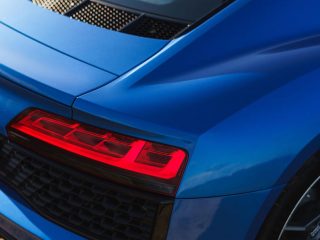 Audi kicks the habit of a lifetime and unleashes its first rear-driven series-production performance car.
Audi kicks the habit of a lifetime and unleashes its first rear-driven series-production performance car.
Audi’s R8 RWD will arrive in Australia in Q3 2020, priced from $295,000 before on-roads in coupe form, and $316,500 for the Spyder. Here is our first-drive review before we get a taste on local roads.
What is it?
This is the Audi R8 RWD – simply, an Audi R8 without the front driveshafts and a special machine for two reasons.
For one thing, when a company builds its entire sporting image around the security of four-wheel drive then chooses to ditch that attribute for its most potent, glamorous model, the narrative feels almost illicit. The R8 LMS racers have been rear-driven for years, yes, but outside the Audi Sport motorsport division, there has never been an Audi that hasn’t pulled itself down the road to some degree, until now.
Well, that’s almost true. In 2017 Audi gave us the excellent R8 RWS (for Rear Wheel Series), but it was built only in limited numbers and our feeling at the time was that Audi wasn’t especially committed to the idea, although it wasn’t hard to see why that might be. If the RWS proved more fun and satisfying to drive than the regular R8 quattro, the marketing message for quattro could become somewhat diluted.
As it happened, the RWS actually was more fun and satisfying, but it was surprisingly distinct from the regular car, with a subtle but meaningfully altered character. In the end, Audi felt its existence didn’t undermine the even faster, more powerful four-wheel-drive R8, and so now the RWS has returned as the series-production RWD. Which is a nice development.
The second reason is this. Who else in 2020 is selling a 325km/h supercar with a mid-mounted, naturally aspirated V10 engine, and doing so for little more than $295,000? No one except Audi, of course. That’s the same price as the latest Porsche 911 Carrera S, once you’ve fitted a few options, and good as the 911 is, the R8 simply has to be considered the bargain of the two. And while the recent facelift applied to the wider R8 range will have left it looking too insect-like and aggressive for some, the changes have at least kept the car feeling cutting-edge. Equally, any subtle-hued R8 won’t have lost its ability to blend into everyday traffic, so it would seem to remain an unusually adaptable machine, even in a superficial sense.
However, that and the fact that Audi also builds the A1, as well as plenty of SUVs, shouldn’t tempt you into thinking the R8 is no thoroughbred. The dry-sumped, 8700rpm engine needs no introduction, but it also uses an aluminium construction underpinned with CFRP for the rear bulkhead and spine of the chassis. Gone is the electrohydraulic multi-plate clutch and differential that distributes drive to the front axle for the regular R8, leaving only the mechanical limited-slip differential at the rear.
Suspension is then by aluminium wishbones all round, controlled by passive dampers, with sensible 19-inch wheels and Pirelli P Zero tyres completing the package. On paper, the R8 RWS is therefore as refreshingly straightforward as it is serious, and constructed very much in the supercar mould.
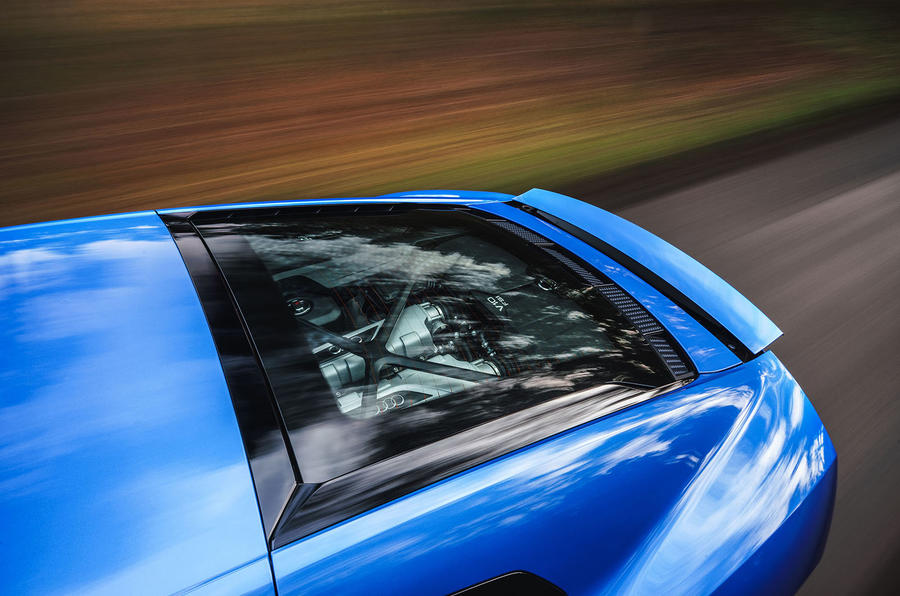
What’s it like?
The second-generation R8 is now five years old, and the interior is starting to feel its age a little. It’s hard to put your finger on exactly why this is, because it still looks and feels superbly well constructed and laid out, but by the lurid standards of mid-engined supercars it’s clinical and conservative in the extreme, and the presence of switchgear from lesser Audi models, some of which have themselves now been updated, doesn’t help.
On the flipside, with the exception of the new, 478kW Porsche 911 Turbo, there’s no supercar cabin I’d rather sit within if I intended to use the car frequently, possibly daily. Storage is genuinely excellent, the ambience is endlessly reassuring and, unlike with the R8’s mad cousin from Lamborghini, natural light floods the driving environment. Audi’s Virtual Cockpit – the fully digital display nestled within the instrument binnacle and that negates the need for any ugly central dashboard screen – can also now mirror smartphones, so while the graphics look slightly rugged compared with the system found in more recent Audi models, there’s no shortage of functionality.
But you could guess the R8 was easy company simply by looking at the seats, which are always a bellwether for any car’s true personality. Here you’ll find no carbon fibre, one-piece buckets clad in Alcantara and replete with harness cutouts and the need for a branded allen key. Instead, there’s just a pair of understated and comfortable part-electric Recaro sports seats. Sliding aboard is less hassle than with even a Mazda MX-5.
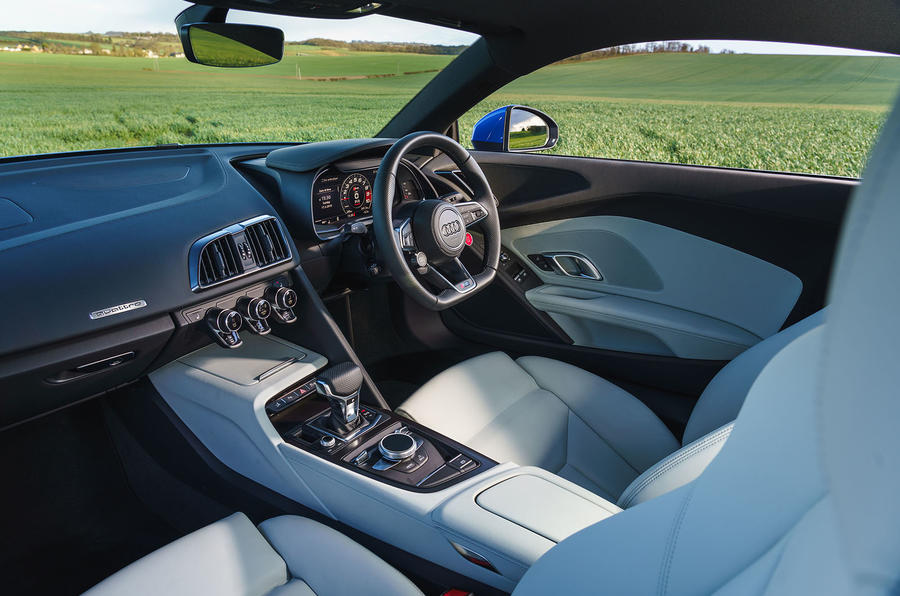
All of which sets you up for the R8 RWD’s second salvo of everyday appeal: it rides phenomenally well. Not just by the standards of the class, but of any class, at least until you get to the lofty heights of the Mercedes-Benz S-Class. You’ll notice it in the manner in which the front axle – lighter than that of the regular R8 – dispatches speed bumps without drama, and the style in which it quickly, quietly glides along freeway lanes, and how it smooths out roads that you know to be pretty lumpy at the best of times.
By not going for broke with cast-iron body control, Audi has given itself freedom with the suspension tune. The setup is passive and so there’s no push-button adjustability, but barely is there any necessity for altering things, and if the Bilstein spring rates are not the softest in all of supercardom, I’d be surprised. The R8 RWD is quite different from the regular R8 in this regard, and while it doesn’t interact and work with the road in quite the same magical way as do many McLarens, the car’s ability to soak up rough stuff makes it feel custom-made. Genuinely, it rides significantly better than most GT cars.
Apart from the car’s unexpected ability to crush day-long drives, what this means is that you’ll drive the R8 RWD fast. It wants to go fast and you’ll want it to go fast, if for no other reason than the fact that the 5.2-litre V10 is strangely subdued below 5500rpm.
Here again, the Audi makes life deceptively easy. In terms of raw throttle response, there’s now daylight between the R8’s more demure-looking V10 and its Performante-sourced counterpart in the new Lamborghini Huracan RWD, but the delivery remains so perfectly linear that even without the front axle working away, straight-line traction isn’t an issue, even on damp roads. Shifts from the seven-speed dual-clutch automatic gearbox are also beyond objective criticism, although the stubby, plastic and thoroughly unromantic paddles have no place in a machine like this.
And when you really want to drive the thing, the R8 RWD has two ways of doing things. At a good lick it’s still a bit aloof, but you can still enjoy the ebb and flow of weight through that double wishbone suspension and the electromechanical steering. This sensation is enjoyably pronounced, although in typical Audi fashion, you get almost nothing of the road texture bubbling up through the firmly padded, perforated leather of the steering wheel rim, and that’s a shame. Body control, despite the fluid ride, is also excellent, if not quite at the same incisive level you get with more senior mid-engined cars, particularly in terms of vertical control. On the track, you might miss that, but on the road it hardly matters.
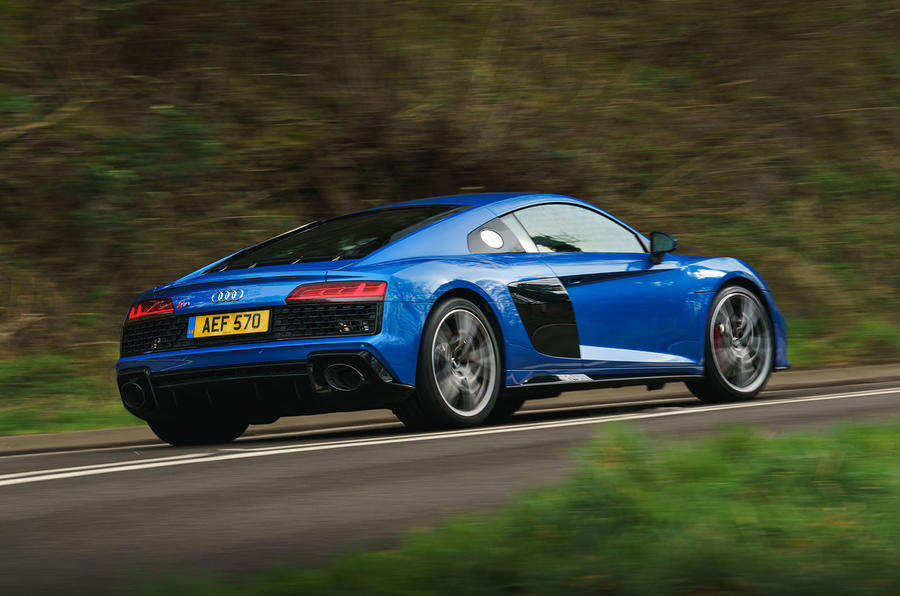
What you get with the R8 RWD are intuitive direction changes (thankfully, there’s been no mucking about with hyper-sensitive initial steering response or strangely variable gearing) and a marginally sweeter and more palpable rear-biased balance (as well as all of the propulsive efforts, 60 per cent of the car’s 1595kg mass is working the back axle) than with the quattro model. In short, you can cover ground at subsonic speed, with quiet satisfaction and without any unpleasant surprises, again playing into the R8’s everyday appeal.
But the other way in which you can drive the R8 RWD is much, much more exciting, and it can challenge you in a way that the regular model simply cannot. This is because the R8 RWD will slide freely and dramatically through second and third-gear corners should you so wish, even if the traction and stability control systems are only in their midway Sport setting. Moreover, and in most un-Audi fashion, there seems to be little in the way of amber-warning understeer to tell you what’s about to happen. Part of the issue here is the steering. As we’ve discovered, it doesn’t communicate the details of what’s brewing down at the contact patch particularly well, and when the car’s tail does begin to rotate, it does so in text-book mid-engined fashion: like a switch being flicked.

Get the application of throttle just right and the chassis will allow you to open the steering a morsel (or, frankly, quite a bit more than that) once you’re heading through and past the apex of a corner. Needless to say, this feels glorious, with the car’s angle of attack faithfully dictated by throttle opening rather than steering angle. In these moments, the control and balance the car possesses also demonstrate the sheer class of Audi’s engineering efforts.
However, the margin for error is slimmer than in any 911 or, to an even greater extent, Aston Martin Vantage, both of which you’ll also be considering at this price point. It’s one reason why the ESP is, in its default setting, draconian in its calibration, the light flickering away especially if the corners you’re splicing through are damp, but also often if they are not.
The takeaway here is that, with the RWD derivative, you quickly need to see through the R8’s deceptively benign demeanour and friendly road manners, because this car takes skill to exploit and fully enjoy and, more so even than many other mid-engined machines, doesn’t tolerate complacency.

Should I buy one?
We said it of the pre-facelift, limited-edition R8 RWS, and the same applies to this new R8 RWD: removing the front driveshafts yields a sweeter-riding, better-steering and finer-handling car. That the RWD is also less expensive than its quattro-equipped range-mate should seal the deal, because neither the 22kW deficit nor the absence of adjustable magnetic suspension, which is standard on the more expensive model, harm its appeal one bit.
There’s also the R8’s exceptional usability to consider. This is an approachable supercar; it keeps its snout a sensible height above the ground, visibility is good and the cabin is comfortable and quiet enough for all-day driving. To that end, our car’s economy of 10.4L/100km also suggests a cruising range of almost 800 kilometres. When you also consider the effortless V10 torque you can lean on at any moment, overall you’ll find the R8 RWD doubles up as a grand tourer very well.
What the R8 doesn’t do – in RWD form or otherwise, and despite its sometimes edgy handling – is gritty involvement. The engine is wonderful, but those searching for an unambiguously ‘connected’ feel from their supercar would be better served by McLaren’s 570S or something along the lines of the 991-generation Porsche 911 GT3. Lightly used examples of both cars can be found for less than the $295,000 of the R8 tested here.
Still, if the R8 takes your fancy – and there are plenty to reasons why it might – be in no doubt that the rear-driven version is the finest of the breed. Owners in wetter climates should carefully consider whether to get the regular quattro model, but they should also know that the RWD amounts to something more entertaining, more challenging, probably more rounded – and yes, something more special.
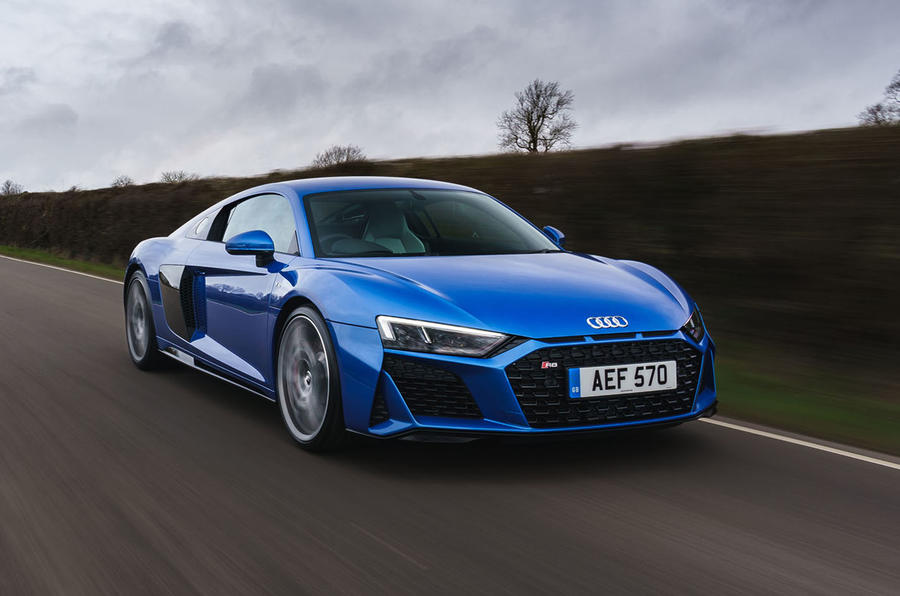
2020 Audi R8 RWD specs and price
Price $295,000 Engine V8, 5204cc, petrol Power 397kW at 7900rpm Torque 540Nm 6400rpm Gearbox 7-spd dual-clutch automatic Kerb weight 1595kg 0-100km/h 3.7sec Top speed 325km/h Economy 10.4L/km CO2 289g/km Rivals Aston Martin Vantage, Porsche 911 Carrera S, McLaren 570S




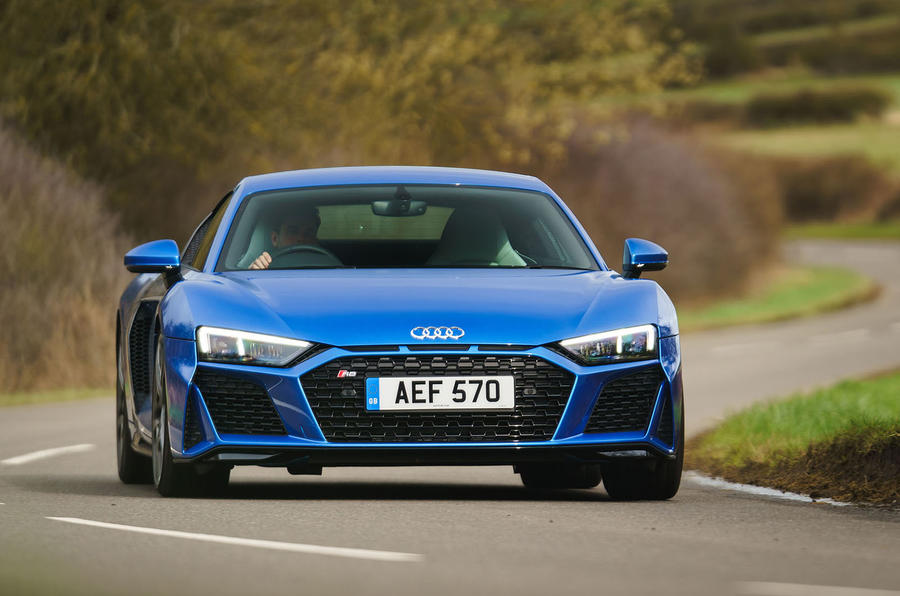 Audi kicks the habit of a lifetime and unleashes its first rear-driven series-production performance car.
Audi kicks the habit of a lifetime and unleashes its first rear-driven series-production performance car.